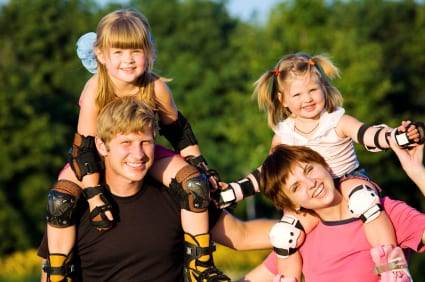Modern Mom was delighted to get a chance to interview fitness expert and Olympic trainer John Abdo about how to promote health and well-being in a family. John suggests that families exercise together, so health becomes a family activity, rather than an individual goal. Love that idea! Here’s some more practical health advice from the this renowned fitness guru and inventor of the Ab Doer Twist:
ModernMom: What are some great exercises the whole family can do together?
John Abdo: How about ‘pretending’ you’re all kick boxers or mixed martial artists and perform three five minute rounds of shadow punching and kicking? Let’s honor Jack Lalanne and see how many sit-ups we can do. Maybe your kids seen a fitness TV show and say to one another, “Hey mom has those cute little pink dumbbells under her bed. Let’s snatch em up, Google ‘dumbbell exercises’ and we can start to build an impressive and strong body ourselves!”
Some objectives for family fitness is variety with some level of self-competitiveness. Utilize whatever machines, implements or methods you currently have access to then be creative. Consider everything, even cleaning out the garage in ‘Cool Hand Luke’ fashion. Develop a chart of all the exercises, equipment, and activities you have access to that comprises your own ‘fitness menu’, and keep it posted in plain view so your entire family can see it.
MM: How often should children exercise?
JA: Depending on age and fitness level, children can, and should, be active everyday. Specific to muscle toning exercise, 3-5 times each week in short bursts; like 10-20 minutes. Mix in some fun activities that condition athleticism, coordination, and stamina; these will expend longer durations. Perhaps a circuit of calisthenics; i.e., pushups, sit-ups, jumping jacks, burpees and Ninja kicking, in that order. As long as your child’s muscles aren’t getting (too) sore after each activity session, an indicator of over-doing-it, they’ll be conditioning a healthy muscular and skeletal metabolism. Periodic visits to your family doctor will monitor progress.
MM: How does exercise affect children?
JA: Aside from the obvious and well-known losses of fat, strengthening and toning of muscle and increases in stamina, if I had to use one word to describe the benefits kids obtain from proper exercise, it would be holistically. Not only is exercise ‘physical’ it’s incredibly ‘psychological’. And psychological can be divided into intellectual and emotional. The decisions needed to exercise, maintain technique, and endure a long-term adaptational process is an incredibly wonderful journey. Most Olympic and professional athletes, who started out as kids, are programmed with skills and habits that are beyond impressive, not only on their respected playing fields but in their business, social and family lives too.
MM: What are some ways to make exercise fun for my children?
JA: Disguise it. “Hey Joey! Let’s see how many jumping jacks you can do in 1 minute!”. Little Joey eagerly says, “Sure Mom! But you better not lose count this time!” Hiring a personal trainer who is certified in ‘youth fitness’ will help a lot. Some kids ‘want’ to exercise because it’s cool and it’s what the older, stronger kids are now doing. These kids could use a few pairs of dumbbells, rubberized tension bands, a medicine ball (or two) and a stability ball. However, there are some kids (and adults) who shy away from exercise. These kids need activities they enjoy; mentally and physically. Develop a ‘family fitness challenge’ while rotating the role as the ‘Family’s Team Captain’, the one who’s in charge of selecting the activity/ies, sets the tempo, counts the repetitions, and screams out motivating remarks like an Army drill sergeant.
MM: As a parent, are there things I can do to prevent my child from getting injured?
JA: Keep your children focused on the task (technique) at hand and make sure they’re not overdoing it. Learning proper technique is a mental attribute that controls the physical anatomy for posture, motion and balance. Correct understanding of exercise conditions the brain-nerve-muscle connections. An effective coaching technique parents can employ is by watching the facial expressions of their children as they exercise. If the child’s face is contorting beyond reasonable expression, like squinting eyes till their tightly shut or clenching teeth until the jaw muscles seem to be locking up, then it’s likely the resistance or task is too tough and they should back down a bit.
 MM: Who has been the hardest-working Olympic athlete you’ve trained? Who has had the best, positive attitude?
MM: Who has been the hardest-working Olympic athlete you’ve trained? Who has had the best, positive attitude?
JA: Hardest working? From my own personal coaching experience I’d have to say, by far, it was Bonnie Blair. The sport of Speed Skating is one thing but the methods Speed Skaters use to condition themselves for Speed Skating competition; World Championships and Olympics included, is an insanely intense ‘other’ thing. Today, looking at all sports in general, and respecting all athletes, I’d have to say that Mixed Martial Arts, in the true scope of the sport, is beyond insane as these athletes have to condition themselves for so many skills and pain tolerances.
Most positive attitude? I can’t boil that down to one person. Plus, you wouldn’t know them by name because so many athletes never make it to the top of their game. Nonetheless, many unknown athletes give it their best shot exceeding anybody’s wildest imaginations on that athlete’s potential. It’s often the under-skilled athlete who has the most determination, drive and passion.





